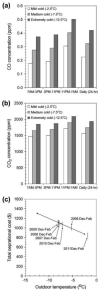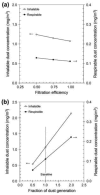Simulation of air quality and cost to ventilate swine farrowing facilities in winter
- PMID: 26937062
- PMCID: PMC4770838
- DOI: 10.1016/j.compag.2013.08.003
Simulation of air quality and cost to ventilate swine farrowing facilities in winter
Abstract
We developed a simulation model to study the effect of ventilation airflow rate with and without filtered recirculation on airborne contaminant concentrations (dust, NH3, CO, and CO2) for swine farrowing facilities. Energy and mass balance equations were used to simulate the indoor air quality and operational cost for a variety of ventilation conditions over a 3-month winter period, using time-varied outdoor temperature. The sensitivity of input and output parameters on indoor air quality and operational cost were evaluated. Significant factors affecting model output included mean winter temperature, generation rate of contaminants, pit-air-exchange ratio, and recirculation ratio. As mean outdoor temperature was decreased from -2.5 °C to -12.5 °C, total operational costs were increased from $872 to $1304. Dust generation rate affected dust concentrations linearly. When dust generation rates changed -50% and +100% from baseline, indoor dust concentrations were changed -50% and +100%, respectively. The selection of a pit-air-exchange ratio was found critical to NH3 concentration, but has little impact on other contaminants or cost. As the pit-air-exchange ratio was increased from 0.1 to 0.3, the NH3 concentration was increased by a factor of 1.5. The recirculation ratio affected both IAQ factors and total operational cost. As the recirculation ratio decreased to 0, inhalable and respirable dust concentrations, humidity, NH3 and CO2 concentrations decreased and total operational cost ($2216) was 104% more than with pit-fan-only ventilation ($1088). When the recirculation ratio was 1, the total operational cost was increased by $573 (53%) compared to pit-fan-only. Simulation provides a useful tool for examining the costs and benefits to installing common ventilation technology to CAFO and, ultimately, making sound management decisions.
Keywords: Air quality; Ammonia; Dust; Simulation; Simulink; Swine farrowing facility.
Figures




Similar articles
-
Use of Recirculating Ventilation With Dust Filtration to Improve Wintertime Air Quality in a Swine Farrowing Room.J Occup Environ Hyg. 2015;12(9):635-46. doi: 10.1080/15459624.2015.1029616. J Occup Environ Hyg. 2015. PMID: 25950713 Free PMC article.
-
Simulation of air quality and operational cost to ventilate swine farrowing facilities in Midwest U.S. during winter.Trans ASABE. 2017;60(2):465-477. doi: 10.13031/trans.11784. Trans ASABE. 2017. PMID: 28775911 Free PMC article.
-
Modeled effectiveness of ventilation with contaminant control devices on indoor air quality in a swine farrowing facility.J Occup Environ Hyg. 2014;11(7):434-49. doi: 10.1080/15459624.2013.875186. J Occup Environ Hyg. 2014. PMID: 24433305 Free PMC article.
-
Wintertime factors affecting contaminant distribution in a swine farrowing room.J Occup Environ Hyg. 2013;10(6):287-96. doi: 10.1080/15459624.2013.777303. J Occup Environ Hyg. 2013. PMID: 23548103 Free PMC article.
-
Epidemiology of house-dust mites.Allergy. 1998;53(48 Suppl):36-40. doi: 10.1111/j.1398-9995.1998.tb04994.x. Allergy. 1998. PMID: 10096805 Review.
Cited by
-
Long-term performance validation of NH3 concentration prediction model for virtual sensor application in livestock facility.Heliyon. 2023 Aug 12;9(8):e19093. doi: 10.1016/j.heliyon.2023.e19093. eCollection 2023 Aug. Heliyon. 2023. PMID: 37636478 Free PMC article.
-
Use of prototype side stream filtration system to control dust levels in a commercial swine farrowing building.J Occup Environ Hyg. 2023 Dec;20(12):633-645. doi: 10.1080/15459624.2023.2247457. Epub 2023 Aug 15. J Occup Environ Hyg. 2023. PMID: 37582250 Free PMC article.
-
Use of Recirculating Ventilation With Dust Filtration to Improve Wintertime Air Quality in a Swine Farrowing Room.J Occup Environ Hyg. 2015;12(9):635-46. doi: 10.1080/15459624.2015.1029616. J Occup Environ Hyg. 2015. PMID: 25950713 Free PMC article.
-
Pre-exposure to hydrogen sulfide modulates the innate inflammatory response to organic dust.Cell Tissue Res. 2021 Apr;384(1):129-148. doi: 10.1007/s00441-020-03333-3. Epub 2021 Jan 6. Cell Tissue Res. 2021. PMID: 33409657 Free PMC article.
-
Simulation of air quality and operational cost to ventilate swine farrowing facilities in Midwest U.S. during winter.Trans ASABE. 2017;60(2):465-477. doi: 10.13031/trans.11784. Trans ASABE. 2017. PMID: 28775911 Free PMC article.
References
-
- American Society of Heating, Refrigerating and Air-Conditioning Engineers (ASHRAE) Ventilation for Acceptable Indoor Air Quality (62-1999) Atlanta, Ga:
-
- Blanes V, Pedersen S. Ventilation flow in pig houses measured and calculated by carbon dioxide, moisture and heat balance equations. Biosyst Eng. 2005;92:483–493.
-
- Brown-Brandl TM, Nienaber JA, Xin H, Gates RS. A Literature review of swine heat prodiction. Am Soc Agric Engs. 2004;47:250–270.
-
- Chang CW, Chung H, Huang CF, Su HJJ. Exposure assessment to airborne endotoxin, dust, ammonia, hydrogen sulfide and carbon dioxide in open style swine houses. Ann Occup Hyg. 2001;45:457–465. - PubMed
Grants and funding
LinkOut - more resources
Full Text Sources
Other Literature Sources
Research Materials
